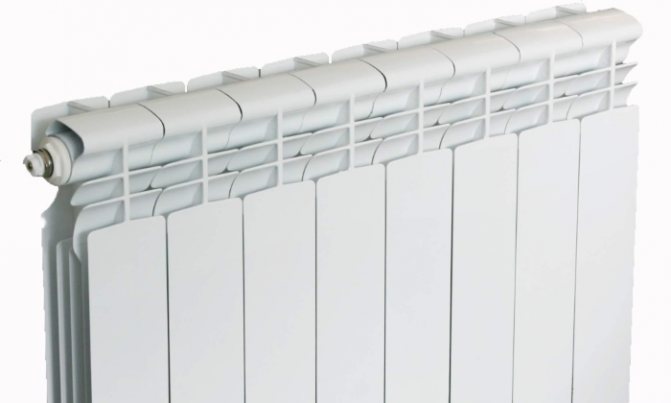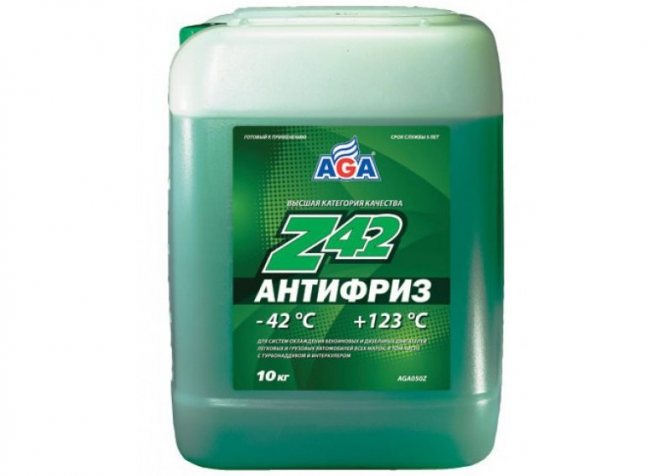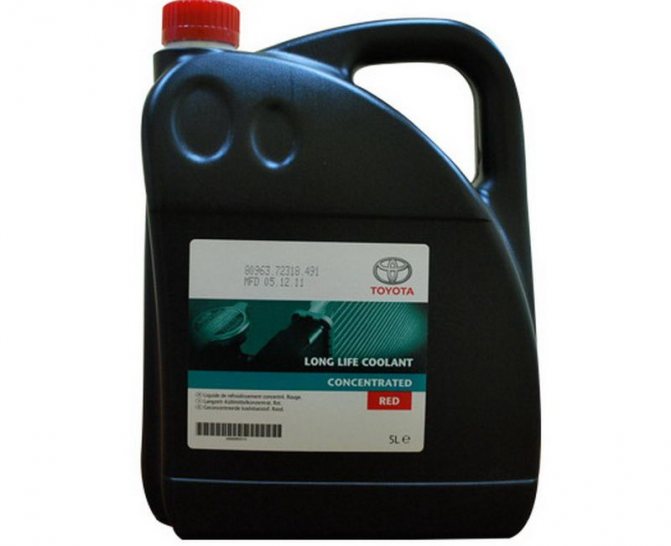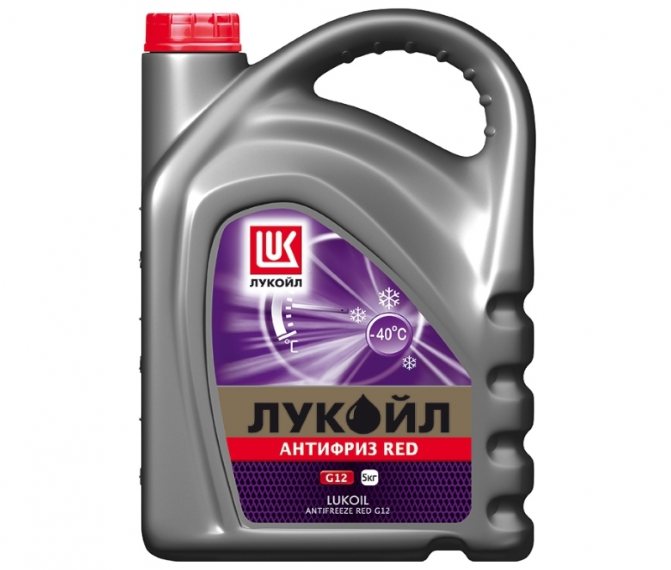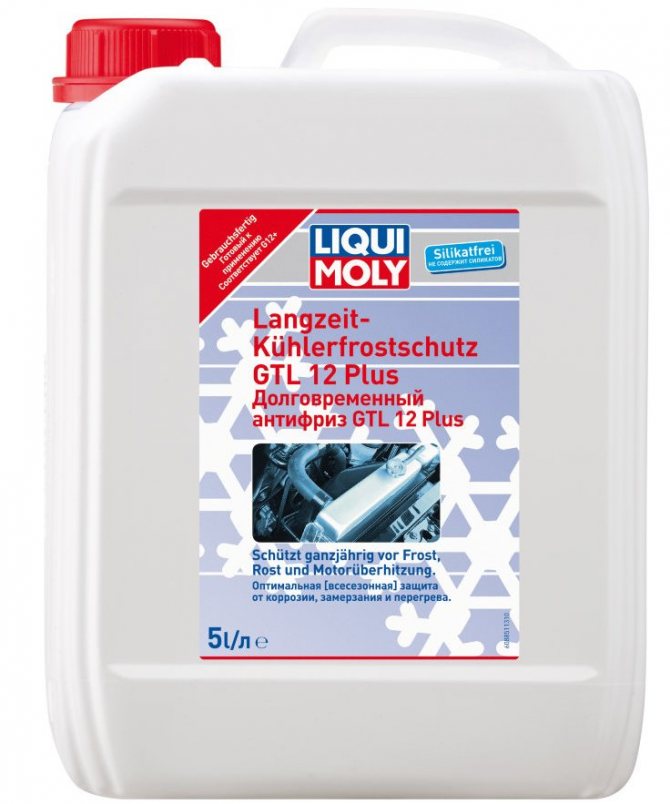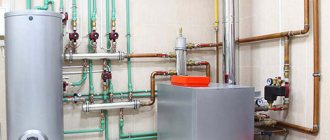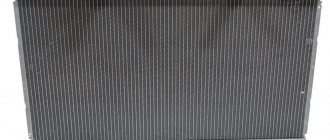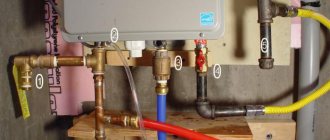Today, the market for antifreeze for car radiators is filled with products based on ethylene glycol. This substance has a number of positive qualities during use. The correct choice of means for the cooling system depends on its durability, as well as the operation of the engine.
Ethylene glycol based antifreeze has a low freezing point, which depends on the concentration of the substance. In this case, the liquid inside the cooling system begins to crystallize in the range from 0 to -70 ° C. When choosing a quality antifreeze, it is necessary to take into account the operating conditions of the machine. In the summer, it must cool the engine as efficiently as possible. In winter, the liquid should not freeze even in severe frosts.
Types of antifreeze
Today there are two main types of antifreeze - carbosilicate and silicate substances. The second type is used in old-style cars. The most famous representative of this class of funds is antifreeze. Silicate antifreezes have a number of disadvantages, so they are not used for foreign cars.
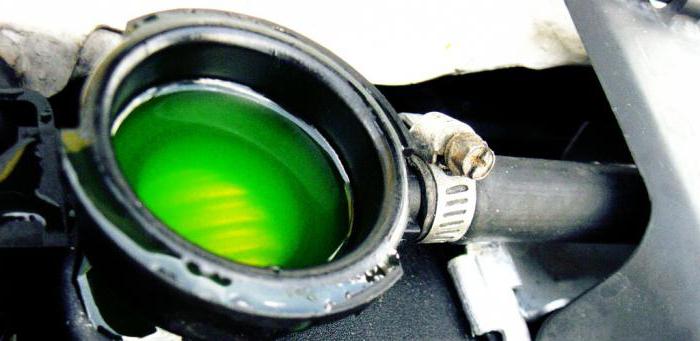
Silicate-free antifreeze based on ethylene glycol is preferable for foreign new cars. The additives that are part of the product, during the operation of the car, settle exclusively in areas where corrosion forms. This became possible due to the inclusion of organic components in the composition of the product. In this case, the engine is fully cooled.
Silicate varieties based on ethylene glycol coat the entire inner surface of the tubes with inorganic components. They effectively prevent the formation of corrosion, but at the same time reduce the cooling capacity of the system.
Propylene glycol for heating systems
As professionals advise, an antifreeze heating system should be planned prior to installation. It should take into account such nuances as the power of the boiler, the material of pipes and shut-off devices, the presence of an expansion tank through which the coolant is supplied to the system.
In the event that the agent is introduced into a system that previously worked on water, then a lot of work will have to be done to recalculate the power and size of its radiators, thoroughly rinse or replace the pipes.
https://www.youtube.com/watch?v=lKKW_NrnUug
If it is necessary to add coolant to the heating system, then you can use only the same brand as when pouring for the first time. Different types of antifreezes enter into a chemical reaction, causing the formation of sludge, and the additional additives present in them will be neutralized.
Summing up, we can say that antifreeze coolant has a number of advantages that attract many consumers. Thanks to antifreeze, aluminum radiators last much longer. It is important to follow the safety rules and not to use the product without protective gloves, and in the case of an ethylene glycol-based carrier, also a mask.
We recommend:
- Flow extension for bimetallic radiator, plugs, taps, nipples and other accessories
- Bimetallic heating batteries: an overview of vertical, floor, monolithic models
- Installation of a warm electric floor (installation instructions)
- How much water is in one section of an aluminum radiator: how to calculate the volume
Propylene glycol is not toxic
Propylene glycol antifreeze for heating systems is an alcohol composition with the addition of propylene.We started with him, as it is he who has the advantage over other lineups. Why is he so good? The main thing is that it is not toxic. Now let's get back to what kind of antifreeze can be used in double-circuit boilers.
As you already understood, propylene glycol antifreeze is best suited for heating systems with a dual-circuit heater. Even if part of the coolant gets into the DHW circuit, it will not bring any harm to a person. Contact with the skin and even inside the body, although undesirable, is not fatal. If in small doses, then even poisoning will not occur.
The characteristics of anti-freeze systems are similar, but there is a qualitative difference between them. That is, propylene glycol has better characteristics than other anti-freeze devices. The only thing that can be attributed to disadvantages is its price, which is twice as much as ethylene glycol.
Let's summarize:
- non-toxic;
- high performance of the additive package;
- expensive.
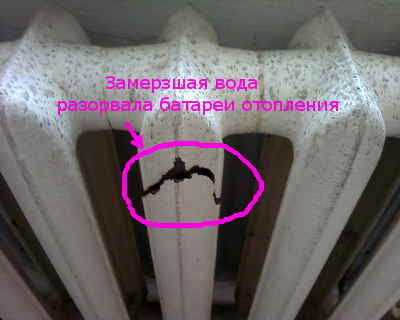

The service life is five years, after which it is necessary to make a complete replacement of the antifreeze in the heating. Otherwise, the additive package stops working and the corrosive effect of antifreeze in a short time will turn the heating circuit into an emergency one.
Molecular structure of ethylene glycol
Very poisonous composition. Moreover, it is poisonous both in liquid form and in gaseous form. If such antifreeze is poured into an open heating system, then the design of the expansion tank must be modified. It must have a lid that closes hermetically. Holes must be made in the lid for the gases to escape. Insert a branch pipe into the hole (also hermetically sealed) and bring it outside the room, to the street.
Contact with skin or eyes is highly undesirable. Therefore, even an ordinary fistula can become a serious danger to others. In no case can it be used in double-circuit heaters, the danger is very serious, you should not tempt fate. It is an inexpensive formulation. Ethylene glycol's additive package is not as good as propylene glycol, so it is cheaper.
We suggest that you familiarize yourself with How to solder an aluminum radiator - we extend the life of the unit on our own
What we end up with:
- very high toxicity;
- low quality of the additive package;
- cheap.
The service life is approximately the same as that of the previous composition. It is also five years, after which a complete replacement is required.
Glycerin is one of the universal elements. What they do not do:
- lubricate the sealing gum;
- process line for winter fishing;
- used in cosmetology;
- restore the skin;
- even the floors are washed.
In general, a miracle is a remedy that is even taken internally. It has lubricating properties and does not freeze. Glycerine antifreeze for heating systems has been used since the middle of the 20th century. You cannot take glycerin from a pharmacy, dilute with water and use it as a heat carrier. Everything is more complicated, because it is necessary to prevent such an undesirable phenomenon as a strong formation of foam, which leads to airing of the circuit, and so on.
The price is in the middle of the two compositions described above, and the service life is twice as much and is 10 years. A very useful quality of glycerol glycol is its ability to restore rubber, as opposed to propylene glycol and ethylene glycol, which dry it out. The disadvantages include the largest weight of the composition among all those considered and the lowest coefficient of thermal conductivity.
Antifreeze composition
Ethylene glycol based antifreezes have a specific composition. Their main characteristics depend on this. In its pure form, ethylene glycol looks like an oily substance. Its freezing point is -13 ° C, and its boiling point is + 197 ° C. This substance is quite dense. Ethylene glycol is a strong food poison. This substance is toxic, especially after depleting its resource.Waste antifreeze based on ethylene glycol, the composition of which has been contaminated during operation with heavy metals, must be properly disposed of.
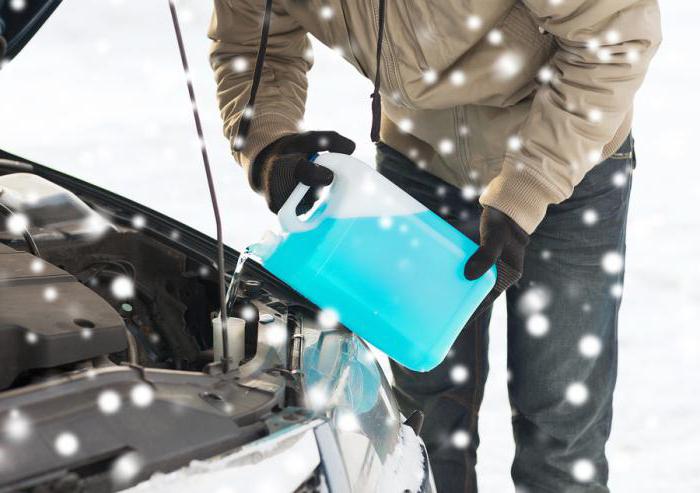

When mixed with water, the freezing point can drop significantly (down to -70 ° C with a water to ethylene glycol ratio of 1: 2). Organic and inorganic components can be used as additives. The first option is preferable. Corrosion inhibitors today come in 4 types: carboxylate, traditional, organic and hybrid. Due to the difference in the components that make up the antifreeze, different brands of these products must not be mixed. Otherwise, they will conflict with each other, reducing the effectiveness of the substance.
Ethyl alcohol based antifreeze
You can make your own radiator mix. To do this, you need: distilled water and 40% ethyl alcohol.
To use antifreeze in the heating system, it is not always possible to fill in ready-made purchased mixtures. In this case, you can use a coolant that is easy to prepare with your own hands. How is this possible, you ask? Everything is very simple, such a coolant is an antifreeze mixture of distilled water and forty percent ethyl alcohol. A similar antifreeze, prepared by hand for a heating system, has the following characteristics:
- the viscosity of the liquid is slightly higher than that of water, but much lower than that of purchased antifreezes;
- fluidity is less than antifreeze, which makes it possible to somewhat reduce the requirements for the tightness of the circuit connections. Rubber seals are not damaged when using just such a liquid;
- Alcohol-based blends have another advantage, making them an excellent choice for metal radiators. The fact is that alcohol prevents the development of corrosion, and this is important for systems, the destruction of which can lead to a variety of troubles;
- in this case, it is recommended to use hard water for the heating system, which, together with alcohol, prevents the formation of scale on the inner surfaces. The precipitate is formed in a solid form, with preventive flushing it is very easily removed from the system;
- when the alcohol content in the mixture is from 30 percent, it does not evaporate separately;
- the boiling point of the alcohol heat carrier is approximately equal to the value for ordinary water. That is, when the temperature rises to 85 degrees Celsius, it does not boil with the formation of large masses of steam;
- alcohol in the coolant reduces thermal expansion, that is, heating pipes and other elements are not damaged during freezing.
Related article: Yellow wallpaper: photo in the interior, gold for the walls, book, colors, light, what color furniture matches yellow wallpaper, video
If you have to choose between water and an alcohol mixture, then many experts recommend giving preference to the second option (if the boiler design allows it). The proportions of such a composition are calculated based on what temperature values are planned:
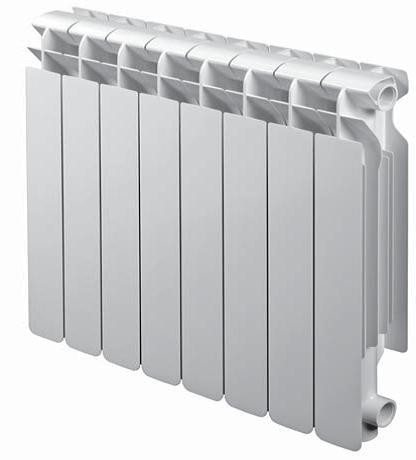

If for some reason the boiler is turned off, it is imperative to drain the hot water from the radiator, otherwise the pipes may rupture.
- when the temperature drops to minus 10.6 degrees, the alcohol content should be 20.3 percent;
- with a decrease to a value of minus 23.6 degrees, the alcohol content is 33.8 percent;
- when freezing to minus 28.7 degrees - the alcohol content should be 39 percent;
- with a decrease to minus 33.9 percent, the alcohol content is 46.3 percent.
When preparing a coolant for aluminum radiators, the volume must be calculated based on the fact that one liter of 96% ethyl alcohol contains 960 ml of anhydrous alcohol.To get a 33% alcohol solution, you need to divide 96 by 33, which will give a volume equal to 2.9 liters. When water is added to one liter of alcohol in an amount of 2.9 liters, we get a 33% alcohol solution, which is an excellent coolant poured into an aluminum radiator for a heating system. The resulting solution will not freeze even at temperatures down to minus 22.5 degrees.
When should antifreeze not be used? But it is not always possible to use such a convenient and effective coolant as antifreeze for a heating system. If you are still choosing which one to use, consider the following factors:
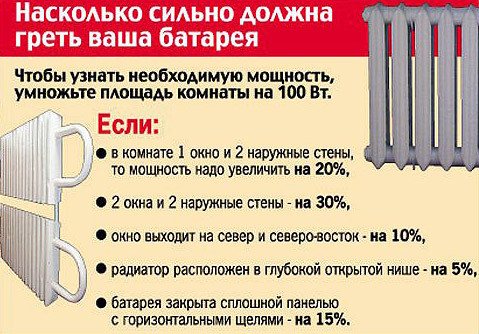

Calculation of the required power of the radiator.
- it is categorically impossible to take antifreeze if ion (electrolysis) boilers are used. In them, heating is carried out by passing current through the entire volume of the boiler tank, and this is unacceptable for antifreeze. When designing a home heating system, make sure that it can be used with a certain type of heat carrier;
- antifreeze must not be used in an open system. But in this case, such a prohibition applies only to those mixtures that are produced on the basis of poisonous ethylene glycol, the rest can be used in open circuits, if there is a manufacturer's indication for this;
- the temperature must not be reduced more than to minus 20 degrees. This can seriously reduce the characteristics of the additives included in the composition, that is, corrosion foci will appear inside the system, scale will appear;
- when making sealed joints, it is not recommended to use linen roll, which is covered with ordinary oil paint on top. When using antifreeze in heating aluminum radiators, it is allowed to use linen winding only with sealants, since oil paint is easily corroded by antifreeze, and this leads to a complete loss of tightness;
- antifreeze must not be used when galvanized fittings and pipes are used for the heating circuit;
- when the boiler heats the coolant to a temperature above 70 degrees Celsius, it is no longer possible to use antifreeze. This value is the limit for most of these mixtures, which have the highest thermal expansion at higher heating.
Related article: Recommendations: how to install a lock in an interior door
Antifreeze color
Initially, ethylene glycol based antifreeze, the color of which can be seen in production, looks like a transparent substance. It only has a specific smell. Regardless of the brand, antifreeze is colorless. Dyes are added to identify its quality. Among drivers and auto mechanics, there is a classification of the quality of the product adopted by them, depending on its color. There are 3 groups of antifreeze.
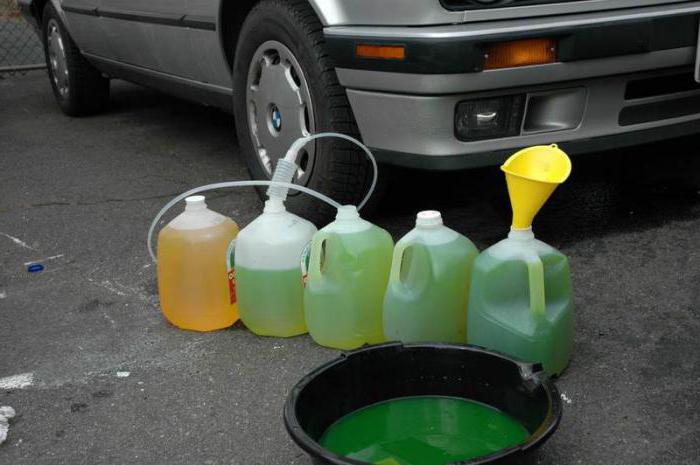

- The G11 class includes blue and green products. These are the cheapest consumables. They include ethylene glycol and silicate additives. The service life of such antifreezes is about 30 thousand km.
- The G12 class includes the red and pink type of substances. They are of higher quality. They contain ethylene glycol and organic additives. The service life of such vehicles can reach 150-200 thousand km. However, their cost is much higher.
- There is also a third class - G13. Its composition, in addition to the components listed in the previous section, includes propylene glycol. The color of such products is most often characterized by orange and yellow shades.
Antifreeze characteristics
Antifreeze characteristics table
Antifreeze is another foreign word that has found application in our rich language. Why our people are so greedy for Western names is unknown, but the fact is obvious. This word consists of two parts "anti" and "freeze", which literally means preventing freezing, in our opinion, non-freezing. Which is better: antifreeze or water in the heating system? Let's figure it out.
The temperature of the gelling (note the gelling, not complete crystallization and transformation into ice) reaches -65 degrees, and more is not needed. In this case, the proportion of dilution with water is important. So these same anti-freezers are very aggressive in themselves and foam when heated. Therefore, they contain a whole bunch of additives that neutralize these negative qualities in every possible way. All non-freezing products have an alcohol (glycol) base on which the following chemical elements are applied:
- propylene;
- ethylene;
- glycerol.
Before choosing antifreeze for heating systems, we will consider each type of anti-freeze separately, but first we will tell you about their general characteristics, which differ from water:
- low temperature of gelling;
- lower thermal conductivity;
- lower surface tension;
- high viscosity;
- greater thermal expansion;
- incompatibility with zinc;
- when overheated, decomposition occurs with precipitation and the release of acids.
The lower thermal conductivity of non-freezing plates is characterized by a decrease in the efficiency of radiators, which requires an increase in their number. Accordingly, the total volume of the coolant in the system will also increase. This, together with a higher viscosity, leads to an increase in the load on the pumps, the power of which must be increased.
At the same time, the surface tension of antifreezes is less than that of water, they are more fluid. This characteristic, on the one hand, is a disadvantage, since the coolant flows out even from very small slots. On the other hand, the greater fluidity slightly smoothes the increased drag due to the viscosity of the formulations.
We invite you to familiarize yourself with Regulating and balancing valves
If at the design stage you already know that antifreeze will be poured into the circuit, then it is better to increase the cross-section of the pipes by one size. This is especially true in open-type circuits, where the coolant circulates only under the influence of gravity.
Antifreeze boils at a temperature of 110 degrees, but, even reaching a mark of 90 degrees, decomposition into a solid silty sediment and acids, which provoke corrosion, occurs in the non-freeze. By the way, additives inhibitors that prevent the destruction of the metal during this process are destroyed. Antifreeze at any temperature is incompatible with zinc, therefore, the use of these compounds in tandem with galvanized pipes is strictly prohibited. Reacting with the zinc layer, antifreeze destroys it and precipitates in the form of flakes.
Marking system
Each antifreeze based on ethylene glycol for aluminum radiators, as well as loaded cooling systems, contains dyes. They do not affect the technical characteristics of the substance in any way. The choice of this or that color depends on the whim of the manufacturer. There is no universally accepted standard for labeling, as well as the addition of colorants.
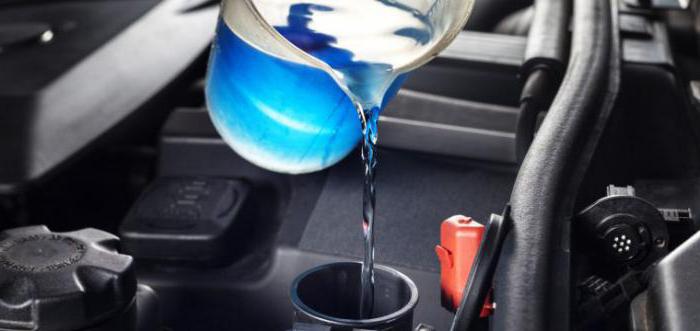

The markings presented above, which are most often taken into account by drivers and auto mechanics, were previously used in the production of German-made VW coolant antifreezes. These funds are very popular. However, even Volkswagen itself has already changed its specifications. Today, this renowned manufacturer produces 3 main classes of organic antifreeze. Their markings have the prefix G12 ++, G12 +++ and G13. Therefore, before buying a means for a cooling system, it is more correct to pay attention to the recommendations of the vehicle manufacturer, as well as the composition of the consumable itself. There is no single labeling for all antifreezes.
Ethanol formulations
The significant cost of this antifreeze for aluminum radiators often becomes a serious obstacle to its use in private autonomous systems. The composition can be obtained from distilled water and 40% ethanol (ethyl alcohol). The quality of such a solution surpasses the factory analogue in some parameters.The point is mainly about its low viscosity (although, compared to water, it remains quite high). Also, there is a decrease in the fluidity of the liquid, which makes it possible to be less demanding on the connecting sections.


The use of homemade ethanol antifreeze for heating radiators has a beneficial effect on the safety of the rubber gaskets that are present in any circuit. It is recommended to dilute alcohol with hard water: in combination with ethanol, it will become a serious obstacle to the formation of scale on the inner walls. In this case, it will not be possible to do without solid sediment, but you can easily get rid of it by flushing the system. In cases where the percentage of ethyl alcohol in the water does not exceed 30%, it will not evaporate.
Due to the fact that the coolant for aluminum radiators is in many ways similar to water in its characteristics, its boiling point is approximately the same as that of water. This means that when the temperature reaches + 85-90ᶷ, steam will not be generated. Thanks to ethanol, the thermal expansion of water is reduced by an order of magnitude, which allows the system to more comfortably endure a decrease in room temperature.
The main properties of antifreeze
In the course of their operation, antifreezes exhibit a whole range of qualities. They are regulated by the standards and approvals of car manufacturers. It should be noted that ethylene glycol is a toxic substance. With the development of its resource, this indicator increases. There are rules on how to dispose of ethylene glycol based antifreeze waste. Various negative properties are attributed to them. Therefore, when replacing antifreeze, you must contact a special organization that will dispose of correctly.
It is also important to consider the foaming properties of antifreezes. For domestic production means, this figure is 30 cm³, and for imported ones - 150 cm³. The wettability of antifreeze is 2 times higher than that of water. Therefore, they are able to seep even into very thin cracks. This explains their ability to flow outward even in the presence of microcracks.
Review of popular brands
In our country, various brands of antifreeze based on ethylene glycol are used. The most popular are Felix, Alaska, Sintek, Long Life, Nord. They are characterized by an optimal ratio of price and quality.
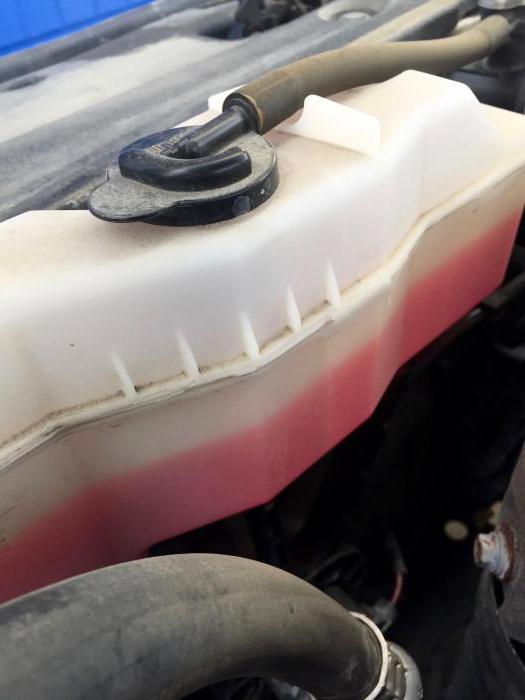

The presented antifreezes are designed for the harsh conditions of our climate. Also, the developed line of tools allows the driver to choose the required tool for the engine of his car. The presented agents effectively resist the formation of corrosion, and also provide good cooling properties of the radiator.
Products popular today in our country effectively protect engine systems from the formation of deposits, especially in the water pump, engine compartment and inlet channels.
Reviews about Sintec G12 antifreeze
Considering the options of which ethylene glycol-based antifreeze to choose for your car, first of all, you need to pay attention to such a tool as Sintec G12. This consumable contains a complex of organic additives. This product is intended for aluminum motors as well as other types of motors.


The crystallization temperature of antifreeze is -41 ° C. AvtoVAZ uses the presented product as the first pouring into the cooling system. It has a wide range of operating temperatures. The relatively low price also makes the product popular.
General information about anti-freezing fluids


Antifreeze in a standard container
Antifreeze for autonomous heating systems is produced on the basis of an aqueous solution of ethylene glycol or on the basis of an aqueous solution of propylene glycol.
In addition to the listed ingredients, a certain amount of additives is added to the solutions. This is done in order to exclude the possibility of foaming of the coolant in the system and in order to prevent corrosive processes inside the heating devices.
Moreover, due to the introduction of special additives, antifreezes do not have a destructive effect on rubber and polymer seals, which are used in considerable quantities in the construction of heating systems.
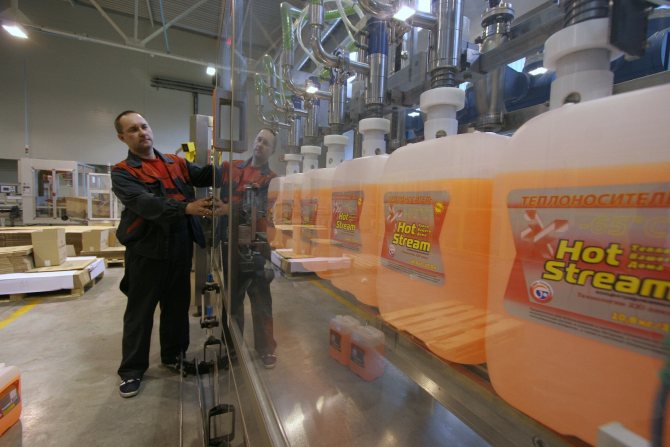

The use of non-freezing coolants in boiler rooms at large facilities
Currently, a wide selection of coolants is presented on the domestic market, which are distinguished by the manufacturer's brand, the ability to work in certain systems and, of course, the price. Products of such brands as Energos Lux, Energos Universal, Thermagent and Dixis have gained widespread popularity.
Immediately, we note that the price of compositions of Russian and foreign production differs significantly. The question is, why can funds intended for performing the same tasks be more expensive or cheaper?
The bulk of Russian products are made on the basis of ethylene glycol.
As a rule, these are tools implemented in two versions:
- modifications designed for temperatures up to - 30 ° С;
- modifications designed for temperatures up to - 65 ° С.
The use of ethylene glycol allows the manufacturer to reduce the cost of the finished product. But when choosing a cheap coolant made with ethylene glycol, you need to understand that it is toxic.
For example, the lethal dose of ethylene glycol is 100 ml. That is, if the system is depressurized, in the event of a break in the connections, a leak is possible, associated with a danger to human health. For timely detection of leaks, ethylene glycol antifreeze is usually painted red.
The specifics of using antifreeze with different types of heating radiators
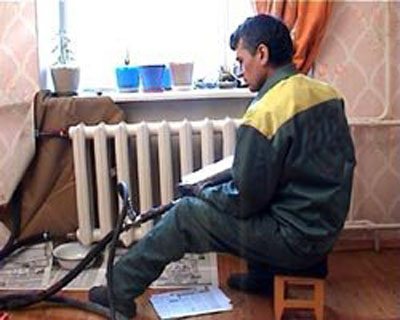

In the photo, the injection of a liquid medium into the system
Can ethylene glycol antifreeze be used for aluminum radiators and for analogs made of other metals?
Important: The compatibility parameters of the coolant and heating devices are indicated by the manufacturer on the canister. Before purchasing, take the trouble to familiarize yourself with the instructions and the compatibility parameters of the product and the heating devices used.
Different types of heaters react differently to the use of antifreeze.
Let's consider what is the reaction of various metals to the coolant.
- Aluminum can form an electrolytic pair if copper pipes or brass valves are used in the system filled with antifreeze;
- Cast iron does not react in any way to antifreeze coolant, provided that the rubber gaskets between the sections are changed to polymer seals;
- Steel, in low pressure systems, does not react to antifreeze, but you have to install large batteries;
- When using antifreeze in bimetal the likelihood of electrolytic pair formation between steel, aluminum and brass fittings increases.
What conclusion can be drawn from the above?
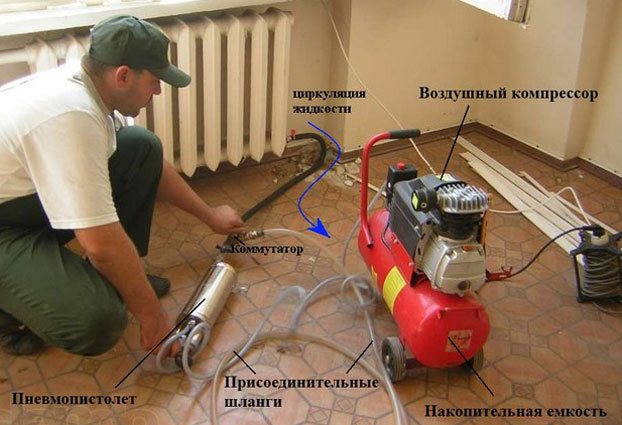

Equipment required for pumping into pipelines and radiators
In order for the heating system to work for a long time without the need for regular repairs, it is advisable to replace the metal pipeline from the boiler to the radiators with polypropylene pipes and polymer shut-off valves.
As connecting fittings, you should select products made of metals that are resistant to the effects of chemical compounds. The best choice for these purposes will be fittings made of steel.
What parameters need to be considered when choosing antifreeze
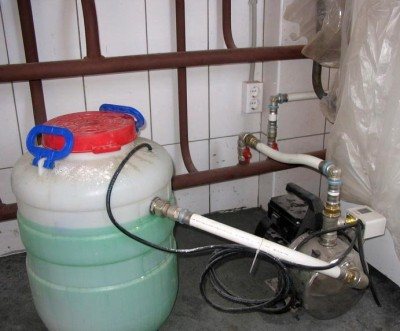

Coolant supply to an autonomous low pressure system
When choosing non-freezing coolants, you need to pay attention to the following characteristics:
- the amount of funds in the canister;
- concentration of antifreeze during use;
- the state of connections in the system;
- heat transfer from heating devices;
- the power of the circulation pump.


Table with the characteristics of heat carriers
Let's consider these points in more detail.
Why, when choosing, it is important to pay attention to the volume of the product, and not to the mass?
The density of water is greater than the density of most antifreezes designed for heating systems. As a result, if the volume of the autonomous system is 100 liters, then 110 liters of antifreeze will have to be poured.
Why is the concentration of the product important when using it?
As a rule, a pure non-freezing coolant is not poured into the system. Before use, the product is diluted with water in a ratio of 3 to 1. Therefore, before use, you need to find out what the instructions for preparing the product are and what concentration is recommended by the manufacturer.
Why is it so important to know the state of connections in an autonomous system? If the heating in the house has been used for a long time, it will be necessary to revise the condition of the joints, namely the gaskets of seals and fittings.
The fact is that most of the seals based on polymeric materials are destroyed from prolonged contact with a liquid medium (degradation process). At the same time, antifreeze is characterized by greater fluidity in comparison with pure water, as a result, if the heating worked with water correctly, when using specialized heat carriers, there is a high probability of leaks.
When planning the use of antifreeze, keep in mind that this liquid medium has a lower heat capacity in comparison with water, therefore, radiators with large dimensions will be required. Also, in order to ensure optimal circulation parameters of non-freezing antifreezes, it will be necessary to install more powerful circulation pumps.
Reasons not to purchase antifreeze coolants


Consequences of improper selection of antifreeze
It would seem that heating radiators are adapted for antifreeze, the use of such a liquid ensures the simplicity and ease of operation of the heating system.
Why do many compatriots still prefer to use ordinary water?
- Firstly, the price of water is cheap, while the cost of special means is high when it comes to heating a country house with an area of over 100 m²;
- Secondly, if for one reason or another a leak has occurred in the system, it is easy to add water with your own hands and restart the boiler;
- Thirdly, do not forget that most of the antifreezes on the domestic market, when leaked, pose a significant hazard due to toxicity;
- Fourthly, many manufacturers of heating boilers refuse to carry out warranty repairs if antifreeze circulated in the system;
- Fifth, the use of an anti-freeze coolant is unjustified in houses used for permanent residence.
Reviews of antifreeze "Felix"
The presented antifreeze is widely used in both cars and trucks. Moreover, this is true even for cars with a forced, loaded engine, turbocharging. This ethylene glycol based antifreeze is used in environments with significant ambient temperature fluctuations. The corrosion protection system acts selectively. It affects only those areas where traces of rust are detected.
The cost of the presented product is also relatively low. Multifunctionality and a wide range of applications make Felix antifreeze popular. However, the temperature of its crystallization is slightly higher than the level allowed by the technical regulations.
Reviews of antifreeze Totachi Long Life
The manufacturer of Totachi Long Life is a Japanese company.The product presented by her is intended for cooling systems of almost all gasoline or diesel engines. The product contains organic components. The operating temperatures at which it is allowed to operate the presented consumables comply with the technical regulations of the vehicle manufacturers. The advantage of Japanese-made antifreeze is a long service life. Its replacement is carried out every 5 years. The presented antifreeze based on ethylene glycol prolongs the life of all elements of the cooling system.


Some users note that the labels on the canister are in English and Japanese only. This causes some discomfort.
Having considered the composition, the main characteristics that ethylene glycol-based antifreeze has, you can choose the best option for your engine. Taking into account the feedback from users and experts about the most popular brands of consumables, it will not be difficult to purchase a quality product.

